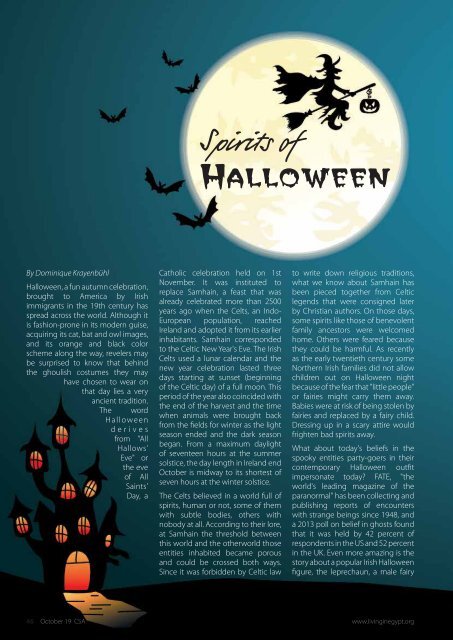You also want an ePaper? Increase the reach of your titles
YUMPU automatically turns print PDFs into web optimized ePapers that Google loves.
By Dominique Krayenbühl<br />
Halloween, a fun autumn celebration,<br />
brought to America by Irish<br />
immigrants in the 19th century has<br />
spread across the world. Although it<br />
is fashion-prone in its modern guise,<br />
acquiring its cat, bat and owl images,<br />
and its orange and black color<br />
scheme along the way, revelers may<br />
be surprised to know that behind<br />
the ghoulish costumes they may<br />
have chosen to wear on<br />
that day lies a very<br />
ancient tradition.<br />
The word<br />
Halloween<br />
derives<br />
from "All<br />
Hallows'<br />
Eve" or<br />
the eve<br />
of All<br />
Saints'<br />
Day, a<br />
Catholic celebration held on 1st<br />
November. It was instituted to<br />
replace Samhain, a feast that was<br />
already celebrated more than 2500<br />
years ago when the Celts, an Indo-<br />
European population, reached<br />
Ireland and adopted it from its earlier<br />
inhabitants. Samhain corresponded<br />
to the Celtic New Year's Eve. The Irish<br />
Celts used a lunar calendar and the<br />
new year celebration lasted three<br />
days starting at sunset (beginning<br />
of the Celtic day) of a full moon. This<br />
period of the year also coincided with<br />
the end of the harvest and the time<br />
when animals were brought back<br />
from the fields for winter as the light<br />
season ended and the dark season<br />
began. From a maximum daylight<br />
of seventeen hours at the summer<br />
solstice, the day length in Ireland end<br />
<strong>October</strong> is midway to its shortest of<br />
seven hours at the winter solstice.<br />
The Celts believed in a world full of<br />
spirits, human or not, some of them<br />
with subtle bodies, others with<br />
nobody at all. According to their lore,<br />
at Samhain the threshold between<br />
this world and the otherworld those<br />
entities inhabited became porous<br />
and could be crossed both ways.<br />
Since it was forbidden by Celtic law<br />
to write down religious traditions,<br />
what we know about Samhain has<br />
been pieced together from Celtic<br />
legends that were consigned later<br />
by Christian authors. On those days,<br />
some spirits like those of benevolent<br />
family ancestors were welcomed<br />
home. Others were feared because<br />
they could be harmful. As recently<br />
as the early twentieth century some<br />
Northern Irish families did not allow<br />
children out on Halloween night<br />
because of the fear that "little people"<br />
or fairies might carry them away.<br />
Babies were at risk of being stolen by<br />
fairies and replaced by a fairy child.<br />
Dressing up in a scary attire would<br />
frighten bad spirits away.<br />
What about today's beliefs in the<br />
spooky entities party-goers in their<br />
contemporary Halloween outfit<br />
impersonate today? FATE, "the<br />
world's leading magazine of the<br />
paranormal" has been collecting and<br />
publishing reports of encounters<br />
with strange beings since 1948, and<br />
a 2013 poll on belief in ghosts found<br />
that it was held by 42 percent of<br />
respondents in the US and 52 percent<br />
in the UK. Even more amazing is the<br />
story about a popular Irish Halloween<br />
figure, the leprechaun, a male fairy<br />
46 <strong>October</strong> 19 CSA<br />
www.livinginegypt.org





